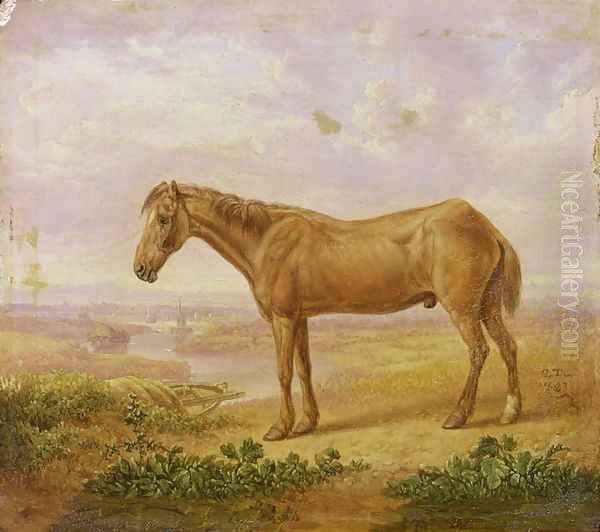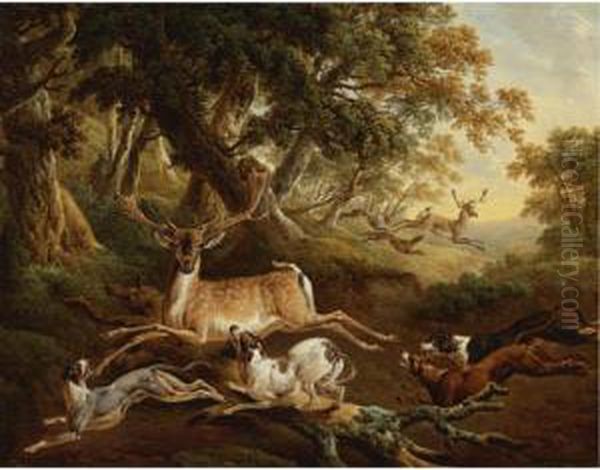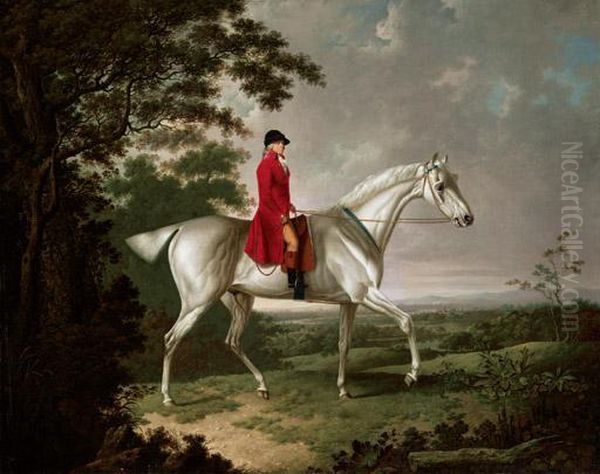Charles Towne stands as a significant figure in the history of British art, particularly renowned for his exceptional skill in depicting animals and landscapes. Active during a period of great change in Britain, bridging the late Georgian and early Victorian eras, Towne carved a niche for himself with his detailed and faithful representations of the natural world, especially the horses and hounds cherished by the gentry of Northern England. Though perhaps not as universally famous as some of his London-based contemporaries, his work possesses a distinct charm and technical proficiency that earned him considerable respect during his lifetime and ensures his place in the annals of British sporting art.
Early Life and Artistic Formation
Charles Towne was born in Wigan, Lancashire, in 1763. His origins were humble, a background that makes his eventual success as a professional artist all the more noteworthy. From an early age, Towne displayed a natural inclination towards drawing. His initial artistic education involved learning the fundamentals of drawing and watercolour painting. Like many aspiring artists of the time, he soon transitioned to working with oil paints, a medium that would define his professional career.
His early working life reportedly included time spent decorating coaches, possibly under the guidance of a craftsman named Charles Stothard. This practical experience, common for artists starting without extensive means, likely honed his skills in precise application and decorative composition. Seeking more formal training and broader opportunities, Towne eventually made his way to London.
In the capital, he is known to have studied at the St Martin's Lane Academy. This institution was a crucial stepping stone for many artists before the full establishment of the Royal Academy Schools, providing valuable life drawing classes and a place to connect with other artists. Towne's time in London exposed him to the wider art world and the works of leading painters, which undoubtedly shaped his developing style. An early influence, particularly in landscape, may have been the Leeds-based painter John Rathbone, whom Towne might have encountered before his London period.
Artistic Development and Key Influences

By the 1790s, Charles Towne had established himself as a capable and mature painter, specializing in the animal subjects that would become his hallmark. His artistic development was significantly shaped by observing the work of prominent artists of the preceding generation and his own time. Perhaps the most crucial influence was George Stubbs (1724-1806), the pre-eminent animal painter of the 18th century. Towne clearly admired Stubbs's commitment to anatomical accuracy and the clear, objective way he portrayed horses and other animals, often against plain backgrounds or within carefully rendered landscapes.
Towne also held the work of George Morland (1763-1804) in high regard. Morland, his exact contemporary, was celebrated for his rustic scenes featuring farm animals, rural figures, and charming landscapes. While Towne's style remained generally more detailed and less 'picturesque' than Morland's, he likely absorbed aspects of Morland's approach to integrating animals into believable, everyday settings.
Another significant influence was Philip James de Loutherbourg (1740-1812). A painter known for his dramatic landscapes and seascapes, often with a dynamic, almost theatrical quality, de Loutherbourg's work may have inspired Towne in the composition and atmospheric treatment of his landscape backgrounds, adding depth and context to his animal subjects. Furthermore, like many British animal painters, Towne would have been aware of the legacy of Dutch Golden Age masters such as Paulus Potter (1625-1654) and Aelbert Cuyp (1620-1691), whose sensitive depictions of livestock in atmospheric landscapes set a high standard for the genre.
Signature Style and Predominant Themes
Charles Towne's artistic style is characterized by its meticulous attention to detail and accuracy. He possessed a remarkable ability to capture the specific likeness of an animal, paying close attention to its anatomy, musculature, and the texture of its coat or hide. His rendering of fur and hair is particularly noteworthy for its fine detail and realism. This precision extended to the landscape settings he often included in his works.
His primary subjects were the animals central to the lives and leisure pursuits of the English gentry. Horses were a frequent focus, ranging from formal portraits of specific mounts, often commissioned by their proud owners, to scenes depicting racing and hunting. He was particularly adept at painting hounds, capturing the various breeds used in foxhunting with great fidelity. Cattle and other domestic livestock also feature in his oeuvre, often situated within pastoral landscapes.

Towne predominantly worked in the North of England, particularly Lancashire and Cheshire, and his landscapes often reflect these specific locales. Unlike the idealized Arcadian scenes favoured by some earlier artists, Towne's settings often feel grounded and specific, depicting the rolling hills, wooded valleys, and riverbanks of his home region. His compositions typically place the animal subject prominently, integrating it harmoniously within its natural environment. While detailed, his style generally avoids the overt sentimentality or high drama that would characterize the work of some later Victorian animal painters like Sir Edwin Landseer.
Notable Works and Patronage
Several works stand out in Charles Towne's extensive output. One particularly well-documented commission was his portrait of Old Billy, painted around 1826. Old Billy was a barge horse reputed to have lived to the remarkable age of 62, making him the longest-living horse on record. Towne's portrait captures the venerable animal's character and serves as an important historical document.
His skill in depicting sporting scenes is evident in works like Stag Hunt and Hunters and a Spaniel in an Extensive Landscape. These paintings showcase his ability to handle complex compositions involving multiple figures, animals, and detailed landscape backgrounds, capturing the energy and atmosphere of the chase. They also highlight his understanding of the specific breeds of horses and dogs favoured by sportsmen of the era.
Towne also produced pure landscapes, sometimes featuring incidental figures that add a touch of narrative or scale. A work titled A wooded river landscape with an angler in the foreground demonstrates his sensitivity to natural scenery and atmospheric effects, showing his capabilities extended beyond purely animal portraiture.
His primary patrons were the landed gentry and prosperous merchants of Lancashire and Cheshire. These individuals commissioned Towne to immortalize their prized horses, hounds, and livestock, and to record their participation in country sports. This reliable base of regional patronage provided Towne with a steady income and allowed him to develop his specialization outside the highly competitive London art market.
The Liverpool Connection
Around 1810, Charles Towne relocated to Liverpool, a city rapidly growing in wealth and importance due to trade and industry. This move proved significant for his career. He became deeply involved in the city's burgeoning art scene. He was a founding member, or at least a very early member, of the Society for Promoting the Arts of Painting and Design in Liverpool, which held its first exhibition in 1810.

This society evolved into the Liverpool Academy of Arts, and Towne played a prominent role in its early years. He served as its Vice-President from 1812 to 1813, demonstrating his standing among his peers in the city. He continued his association with Liverpool's artistic institutions, later becoming a member of the Liverpool Royal Institution and serving as its Vice-President in 1832.
His presence helped to solidify Liverpool as a significant provincial art centre during the Industrial Revolution. Towne is sometimes referred to as one of the "Little Masters" – skilled professional artists who catered to the tastes and needs of patrons in regional centres, providing high-quality work outside the dominant influence of the London Royal Academy. He was arguably the leading animal painter in the North West during his active years there.
Contemporaries and Reputation in His Time
Charles Towne worked during a vibrant period for British art. While influenced by Stubbs and Morland, he was contemporary with a new generation of animal and sporting artists. Sawrey Gilpin (1733-1807) was an elder figure whose work bridged Stubbs's era and Towne's. More direct contemporaries included Benjamin Marshall (1768-1835), known for his dynamic and fashionable portraits of racehorses and jockeys, often capturing the specific atmosphere of Newmarket.
John Frederick Herring Sr. (1795-1865) rose to prominence later in Towne's life, achieving immense popularity for his depictions of farmyard scenes and racehorses, particularly winners of the St. Leger and Derby. James Ward (1769-1859), Stubbs's brother-in-law, was another major figure, known for his powerful, sometimes Romantic, depictions of animals and large-scale landscapes. Henry Thomas Alken (1785-1851) specialized in lively, often humorous, coaching and hunting scenes.
Towne's work was recognized by his peers. The diarist Joseph Farington (1747-1821), himself a landscape painter and an influential figure in the Royal Academy, noted Towne's work, indicating his visibility within the broader art community. While Towne exhibited works occasionally at the Royal Academy in London (starting in 1806) and the British Institution, his primary exhibition venues were in Liverpool.
His reputation was solid, particularly in the North. He was respected for his technical skill, his reliability in capturing a likeness, and his dedication to his craft. His style, while meticulous, perhaps lacked the innovative flair or dramatic intensity of some contemporaries like James Ward or the emerging landscape giants J.M.W. Turner (1775-1851) and John Constable (1776-1837), whose approaches to landscape painting were revolutionizing the genre during Towne's lifetime. Towne remained largely faithful to the detailed, observational tradition.
Avoiding Confusion: A Different Charles Towne

It is important to distinguish Charles Towne (1763-1840), the animal painter, from another artist named Charles Towne (or Town), who lived from 1781 to 1854. This younger Charles Towne was also an artist, primarily known as a landscape and figure painter, and is noted in some sources as being of Jewish heritage. Their overlapping names and periods can occasionally lead to confusion, but their subject matter and stylistic focus were generally different. The artist discussed here is definitively the one born in Wigan in 1763, celebrated for his animal and sporting pictures.
Legacy and Place in Art History
Charles Towne died in Liverpool in 1840. His legacy lies primarily in his contribution to the genre of British animal and sporting art. He successfully carried forward the tradition of detailed animal portraiture established by Stubbs, adapting it to the tastes of provincial patrons in the burgeoning industrial North. His work provides valuable documentation of the specific breeds of horses and dogs favoured during his time, as well as glimpses into the landscapes and rural pursuits of Northern England.
While his style might have appeared somewhat conservative compared to the rising tide of Romanticism, its strength lies in its honesty, precision, and craftsmanship. He trained or influenced other artists, including his pupils James White, a lawyer, and James White Abbott, who was Towne's nephew and later became involved in the gallery world.
In the grand narrative of British art, Charles Towne occupies a respected position, particularly within the specialized field of animal painting. He was a highly skilled practitioner who served his patrons well, contributing significantly to the artistic life of Liverpool and the North West. His paintings remain appealing for their detail, accuracy, and the quiet dignity with which he portrayed his animal subjects within their carefully rendered environments. His work continues to be sought after by collectors of sporting art and stands as a testament to a long and dedicated artistic career.